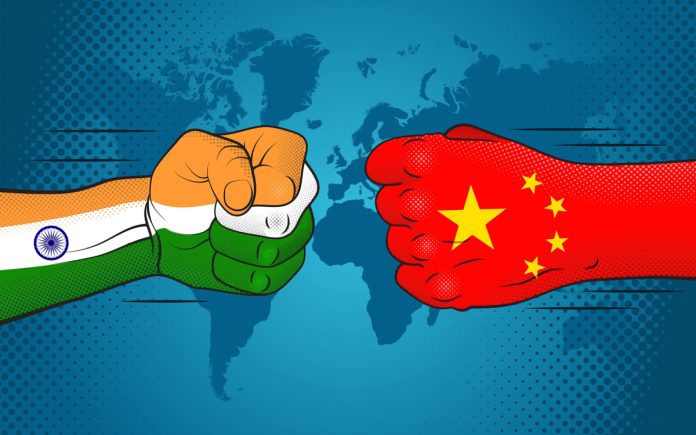Nusrat Mirza
The possibility of war between India and China, two of the world’s largest and most powerful nations, is a subject of considerable concern and analysis. With a long and contentious shared border, their relationship is marked by a blend of cooperation, competition, and conflict. This article explores the historical context, geopolitical dynamics, military capabilities, economic interdependence, diplomatic efforts, and the influence of external powers to evaluate the likelihood of conflict and its implications for regional and global stability.
Historical context
The roots of India-China tensions lie in historical territorial disputes, particularly in three key areas: Aksai Chin in the western sector and Arunachal Pradesh in the eastern sector. Aksai Chin is controlled by China but claimed by India, whereas Arunachal Pradesh is administered by India but claimed by China as part of South Tibet. The 1962 Sino-Indian War was a significant military conflict over these regions, resulting in a Chinese victory and substantial territorial gains for China. The third issue between China and India regarding Tibet where recently the American Congress passed a bill to Resolve Tibet Act. This Act will further aggravate the relationship between China and India.
Since the 1962 war, there have been numerous border incidents and skirmishes, with the most recent and significant clash occurring in the Galwan Valley in June 2020. This confrontation resulted in the first combat fatalities between the two countries in over four decades, highlighting the ongoing volatility of their border disputes.
Geopolitical rivalry
China and India are not just neighboring countries; they are also rivals for regional dominance in Asia. China’s Belt and Road Initiative (BRI) and its expanding influence in South Asia through investments and infrastructure projects are viewed with suspicion by India. New Delhi perceives the BRI as a strategic encirclement, often referred to as the “String of Pearls,” aimed at limiting India’s influence in its neighborhood.
In response, India has sought to strengthen its strategic partnerships with countries like the United States, Japan, and Australia, particularly through the Quad (Quadrilateral Security Dialogue). This grouping is seen by China as an attempt to counterbalance its rise, adding another layer of complexity to the India-China rivalry.
Military modernization and capabilities
Both China and India have been significantly upgrading their military capabilities. China’s People’s Liberation Army (PLA) is the world’s largest standing army, bolstered by advanced missile systems and a rapidly modernizing navy and air force. India, while not as technologically advanced as China in some aspects, has been investing heavily in modernizing its military, focusing on indigenous production and strategic partnerships with countries like the United States, Russia, and Israel.
The military buildup along the Line of Actual Control (LAC) has led to an arms race, increasing the potential for both accidental and intentional escalation. The deployment of advanced weaponry, including fighter jets, tanks, and artillery, along the LAC underscores the readiness of both nations for potential conflict.
Economic interdependence
Despite their political and military tensions, India and China share significant economic ties. China is one of India’s largest trading partners, with bilateral trade surpassing $100 billion annually. This economic interdependence serves as a deterrent to conflict, as war would be economically detrimental to both nations. However, it can also be a source of leverage. Following the 2020 Galwan clash, India imposed restrictions on Chinese investments and banned numerous Chinese apps, illustrating how economic tools can be used in geopolitical disputes.
Diplomatic efforts and conflict resolution mechanisms
Both countries have established various mechanisms to manage their differences and avoid conflict. These include high-level dialogues, border personnel meetings, and confidence-building measures. Agreements such as the 1993 Border Peace and Tranquility Agreement and the 2005 Protocol on Modalities for the Implementation of Confidence Building Measures are examples of such efforts.
However, these mechanisms have not always been effective in preventing or de-escalating tensions. Differing strategic cultures and perceptions of threat complicate diplomatic resolutions. China’s assertive foreign policy under President Xi Jinping and India’s increasingly nationalistic stance under Prime Minister Narendra Modi further complicate diplomatic efforts.
The role of external powers
The involvement of external powers, particularly the United States, adds another layer of complexity to India-China relations. The US has been strengthening its strategic partnership with India as part of its Indo-Pacific strategy aimed at countering China’s influence in the region. This includes arms sales, joint military exercises, and intelligence sharing. China views these developments with suspicion, interpreting them as part of a broader strategy to contain its rise. This external dimension can exacerbate tensions, as both India and China may feel compelled to demonstrate their resolve and military capabilities.
Future scenarios: conflict and peace
While the possibility of war between India and China cannot be entirely dismissed, several scenarios could either escalate or mitigate tensions. ESCALATION SCENARIOS:
- Border Incidents: Accidental or intentional skirmishes along the LAC could escalate into a larger conflict, especially if casualties occur.
- Nationalistic Pressures: Domestic political pressures and nationalistic sentiments in both countries could drive leaders.
- The Resolve Tibet Act of USA shall create further tension between two neighboring countries.
The author is the Chief Editor of Monthly Interaction.







